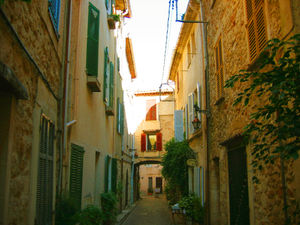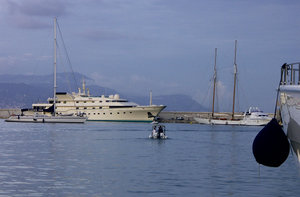Antibes
From Wikipedia, the free encyclopedia
Commune of Antibes A typical provençal ruelle in Antibes |
|
| Location | |
| Location | |
| Longitude | 07° 07' 26" E |
| Latitude | 43° 34' 51" N |
| Administration | |
|---|---|
| Country | France |
| Région | Provence-Alpes-Côte d'Azur |
| Département | Alpes-Maritimes |
| Arrondissement | Grasse |
| Canton | Chief town of 2 cantons |
| Intercommunality | Communauté d'agglomération de Sophia Antipolis |
| Mayor | Jean Leonetti (UMP) (2001-2008) |
| Statistics | |
| Altitude | 0 m–163 m (avg. 9 m) |
| Land area¹ | 26.48 km² |
| Population² (1999) |
72,412 |
| - Density (1999) | 2,734.6/km² |
| Miscellaneous | |
| INSEE/Postal code | 06004/ 06600 |
| ¹ French Land Register data, which excludes lakes, ponds, glaciers > 1 km² (0.386 sq. mi. or 247 acres) and river estuaries. | |
| ² Population sans doubles comptes: single count of residents of multiple communes (e.g. students and military personnel). | |
Antibes (Provençal Occitan: Antíbol in classical norm or Antibo in Mistralian norm) is a resort town of southeastern France, on the Mediterranean Sea in the Côte d'Azur, located between Cannes and Nice. It is c. 20 km by rail southwest of Nice, and is situated on the east side of the Garoupe peninsula.
It was formerly fortified, but all the ramparts (save the Fort Carré, built by Vauban, and the ramparts along the sea coast), were demolished in the 1860s. A new town then rose outside the former defenses.
Antibes has one of the largest yacht marinas on the Côte d'Azur, built in the 1960s on the site of a Roman harbor. There is still a local fishing industry, much diminished from its size a century ago. It was formerly a site of perfume distilling; the surrounding country once produced an abundance of flowers. Perfume distillation is still carried out on a commercial scale in nearby Grasse.
Contents[hide] |
[edit] Administration
Antibes is a commune of the Alpes-Maritimes département (formerly in that of the Var, but transferred after the Alpes-Maritimes department was formed in 1860 out of the county of Nice). It covers a number of distinct areas, including:
- Antibes proper
- Juan-les-Pins
- Golfe-Juan
- the southern parts of Sophia Antipolis (the northern parts belonging to Biot)
[edit] History
[edit] Greek Antipolis
In prehistory, the area around Antibes was inhabited by the Deciates (Δεκιῆται), a tribe of the Ligurians (Smith, entry on Deciátes; Cosson, pp.20-23). The border with the Ligurian Oxybii (Ὀξύβιοι) being to the west of Antibes and east of Frejus (Smith, entry on Oxybii). The Deciates had a town in the area, oppidum Deciatum but this was not Antibes itself (Pliny the Elder, Chorographia, 2.69):
- In litoribus aliquot sunt cum aliquis nominibus loca: ceterum rarae urbes quia rari portus, et omnis plaga austro atque africo exposita est. Nicaea tangit Alpes, tangit oppidum Deciatum, tangit Antipolis.
Antibes was the ancient Antipolis (Stabo, Geography 4.1.9). It was founded as a colony of Massallia (Marseilles), in the 6th century BCE, across the bay from Nikea (Nice); the name in Greek means literally "city across" or "city opposite," Anti polis, and is mentioned in the Geography of Strabo. Although no traces of the Greek port remain, wrecks of sunken ships (such as a 6th century BCE Etruscan ship) attest to the importance of this early port.
Polybius (Histories, 33.7) relates that in 155 BCE the Ligurians attacked Massallia, Antipolis and Nikea and in consequence, Massallia appealed to the Romans for help because of a treaty between Massallia and Rome. The resulting defeat of the Deciates and Oxybii also led to greater Roman involvement in the region, culminating in the battle of Aquae Sextiae in 102 BCE and the creation of the Roman province of Narbonensis along the coast from the Alps to the Pyrenees.
[edit] Roman Civitas Antipolitana
In 43 BCE, Antipolis lost its staus as a free Masaliote city and was annexed by the Romans, becoming Civitas Antipolitana. This was later referred to by Strabo (Geography, 4.1.9):
- although Antipolis is situated in the Narbonnaise, and Nicæa in Italy, this latter is dependent on Marseilles, and forms part of that province; while Antipolis is ranked amongst the Italian cities, and freed from the government of the Marseillese by a judgment given against them.
[edit] Tourism
The major attractions of Antibes are its history, climate, art, beaches and yachting.
[edit] Cap d'Antibes
The southern peninsula of Antibes is known as Cap d'Antibes. A bastion of wealth and exclusivity, it was the setting for F. Scott Fitzgerald's Tender is the Night. The Hotel du Cap, called Hôtel des Étrangers in the novel, is still one of the most expensive and exclusive hotels in the world.
[edit] Antibes culture
[edit] Literature
Antibes was the birthplace of Jacques Audiberti (1899-1965), author.
The author Graham Greene spent the last quarter century of his life in Antibes, from 1966 to 1991. Anthony Burgess wrote a series of essays, A Homage to QWERTY, about his travels from Monaco to Antibes to interview Greene.
[edit] Music
Interestingly, Antibes was the site of two well-regarded live jazz performances - the Charles Mingus album Mingus at Antibes and a live performance of John Coltrane's A Love Supreme, which was later released with the original in a deluxe package.
The electronic music group M83 is from Antibes.
[edit] Art
The Musée Picasso, located in the mediaeval Château Grimaldi, contains Pablo Picasso's works from the year-long period he spent in Antibes.
The Musee Peynet et du Dessin Humoristique has a permanent exhibition of the works of Peynet and has temporary exhibitions of graphic arts, humour, and satire. The museum is built on the site of the Roman temple to Saturn (Cosson p.131).
[edit] Miscellaneous
Antibes is twinned with Aalborg, Denmark; Olympia, Greece; Kinsale, Republic of Ireland and Newport Beach, California, United States.
[edit] See also
[edit] Sources and references
- Cosson, Pierre (1995) Civitas Antipolitana: Histoire du Municipe Romain d'Antipolis.Nice, Serre Editeur. ISBN 2-86410-219-6
- Pliny the Elder, Chorographia, II.69
- Polybius, Histories 33.7. Available online
- Smith, William (1854) Dictionary of Greek and Roman Geography.
- Strabo, Geographia, 4.1.9. Available online
- This article incorporates text from the Encyclopædia Britannica Eleventh Edition, a publication now in the public domain.
- This article incorporates text from the public-domain Catholic Encyclopedia. Nice
[edit] External links
- City council website
- Webpage about the Fort Carré
- Webpage about Real Estate in Antibes
- Street map of Antibes and Juan-les-Pins
Categories: Wikipedia articles incorporating text from the 1911 Encyclopædia Britannica | Derived from Catholic Encyclopedia | 6th century BC establishments | Ancient Greek cities | Archaeological sites in France | Communes of Alpes-Maritimes | French Riviera | Massalian colonies | Roman Catholic dioceses in France | Roman Gaul | Roman towns and cities in Provence


